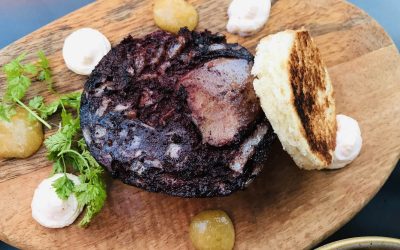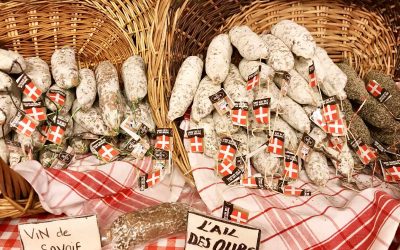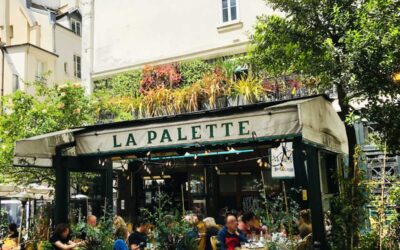The French aren’t just famous for their fashion sense and general good looks, they are also known for producing chefs who have become famous for being culinary artists.
Instead of resting on their laurels, many a grand French chef has made his/her name by taking risks and perfecting new techniques to take their cooking to the next level.
And lucky for us, these French cooking terms and techniques have been shared with the masses so that we can all try to incorporate them into our cooking! (With success, we hope.)
Cooking is an art, not a science. And it is one that anyone can try and become good at. If you’re a beginner, it might seem a little daunting, but many of these cooking techniques are not quite as complicated as they sound once you get past the name.
So let’s get to the top French cooking terms and techniques, so that we can all sound like experts, shall we? Allons-y!
- Aioli
- Amandine
- Bain-marie
- Béchamel
- Béarnaise
- Beurre Blanc
- Beurre Noisette
- Bien-cuit
- Bisque
- Blanche
- Blanquette
- Bouillon
- Bouquet Garni
- Brunoise
- Chiffonade
- Confit
- Coulis
- Croquette
- (en) Croute
- Déglacer
- Démi-glace
- Escalope
- Espagnole
- Farci
- Flambé
- Fondue
- Fricassée
- Frit
- Fumé
- (au) Gratin
- Hollandaise
- Hors d’oeuvre
- Julienne
- (au) Jus
- Meunière
- Mijoter
- Mirepoix
- Pâté
- Pistou
- (en) Papillote
- Poaché
- Ragoût
- Remuer
- Rillettes
- Rouille
- Roux
- Saignant
- Sauté
- Soufflé
- Sous Vide
- Tartare
- Tartine
- Terrine
- Tomate
- Vélouté
- Verrine
- Vol-au-Vent
Aioli
Aioli is a strong garlic flavored sauce that originated in Marseille, in the south of France. Ingredients in the aioli sauce include garlic, egg yolks, olive oil, lemon juice, and mustard. It is a type of mayonnaise, only with more garlic.
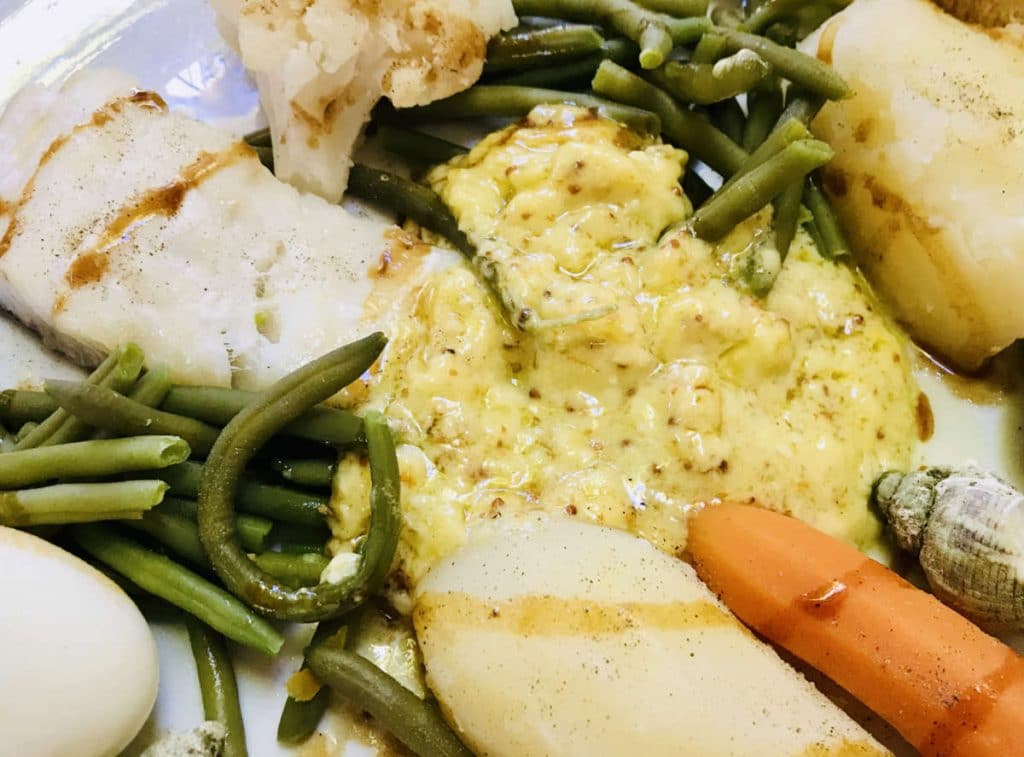
A classic of French cuisine, aioli is usually prepared and served with steamed or poached codfish, lightly seasoned with herbs, olive oil and lemon.
But you can also try it with other fishes sea bass, crab cakes, shrimp or other types of seafood.
As a side, add steamed fresh vegetables like carrots, potatoes, asparagus, or other vegetables that are in season. You can get the recipe for aioli sauce here.
Amandine
Amande is French for almonds. Dishes that are topped off with chopped almonds, are referred to with amandine in their name. Eg. Tarte amandine.
Bain-marie
A bain-marie is a french cooking technique, that is usually used to get eggs and butter to emulsify.
Sometimes called a bain chaud (meaning “hot bath”), it just involves placing your preparation bowl in a bigger dish that contains hot water. The technique involves slowly combining the eggs and the melted butter while the mixing bowl is in the bain marie.
The traditional French hollandaise recipe involves a bain marie. Which sounds a whole lot more intimidating that it actually is.
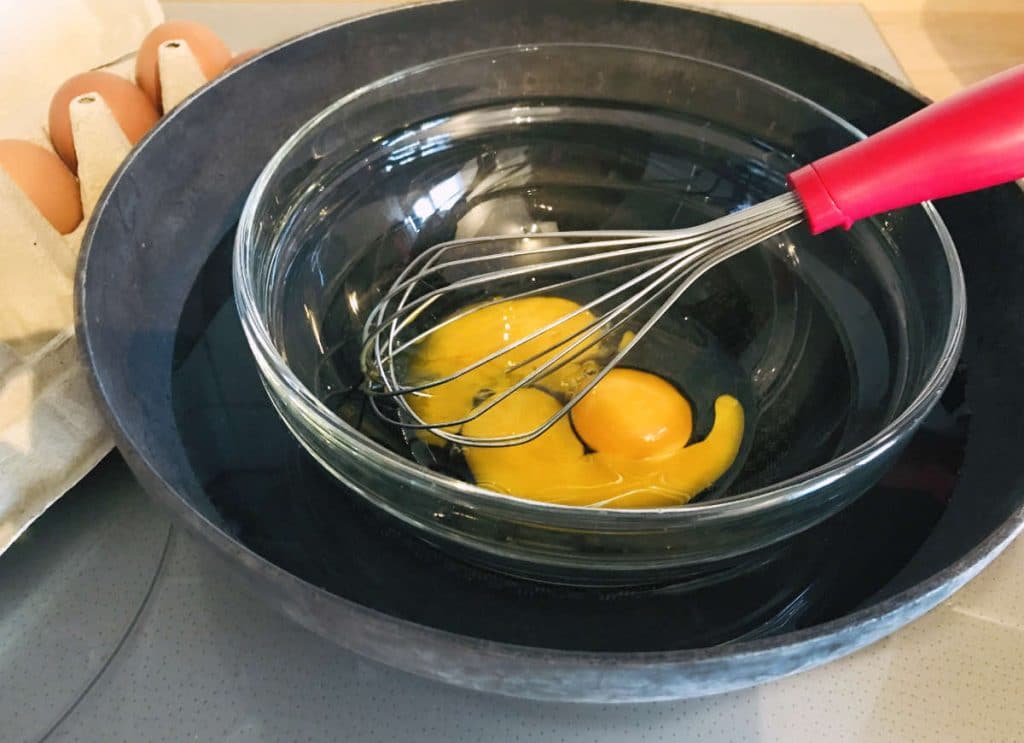
In order to get the eggs and butter to emulsify (i.e. to combine) the eggs need to be warm, but not too warm. So placing it on the stove is out of the question.
The temperature of the water for a bain marie should not exceed 150°F (65°C), as the eggs will start cooking, and you will have scrambled eggs instead. Around 3-4 cm of water is sufficient in the larger dish. Mix the egg and melted butter together slowly, and you have just accomplished a bain-marie.
Béchamel
A béchamel sauce is one of the 5 mother sauces that remain the base of French cuisine. Ingredients in the béchamel sauce include butter, flour, and milk.
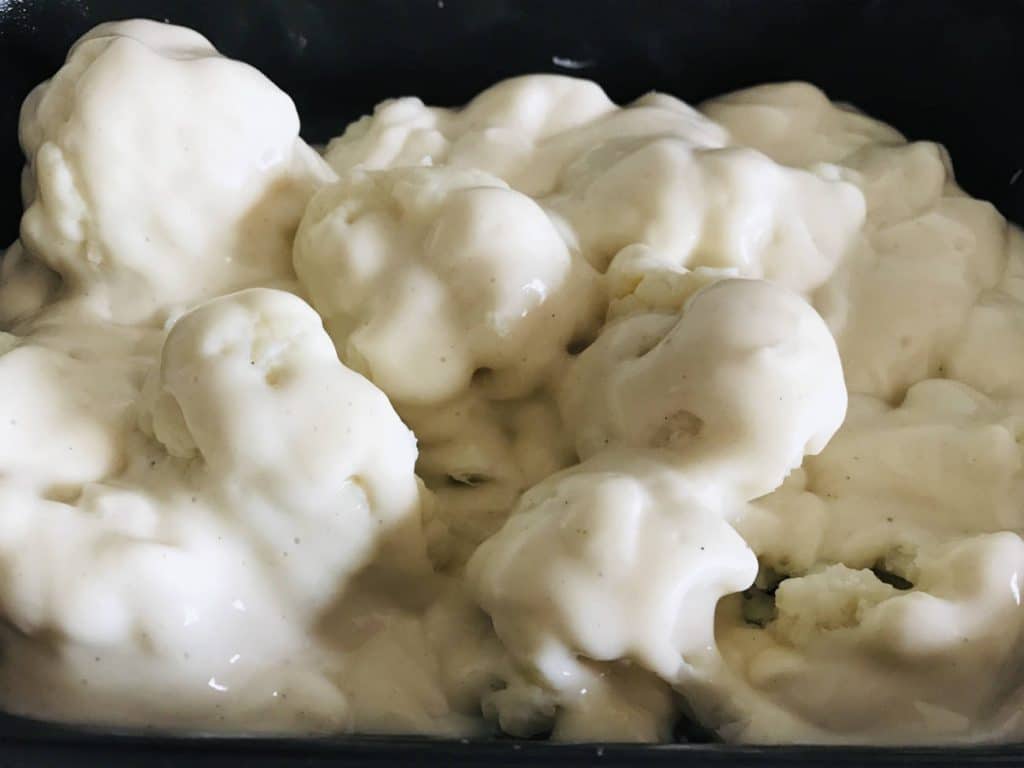
You can use béchamel sauce almost any sort of dish, from pasta bakes and lasagna, to baked chicken. It can also go directly on cooked or steamed vegetables like spinach, cauliflower or broccoli.
Other daughter sauces include:
- Mornay: béchamel with onion, cloves, Gruyère cheese, and Parmesan
- Soubise: béchamel with butter and caramelized onions
- Nantua: béchamel with shrimp, butter, and heavy cream
You can get the recipe for béchamel sauce here.
Béarnaise
The béarnaise sauce is another one of those French sauces that is usually serve with a nice piece of red meat like prime rib or lamb that has been cooked on a stove, in the oven, or charbroiled.
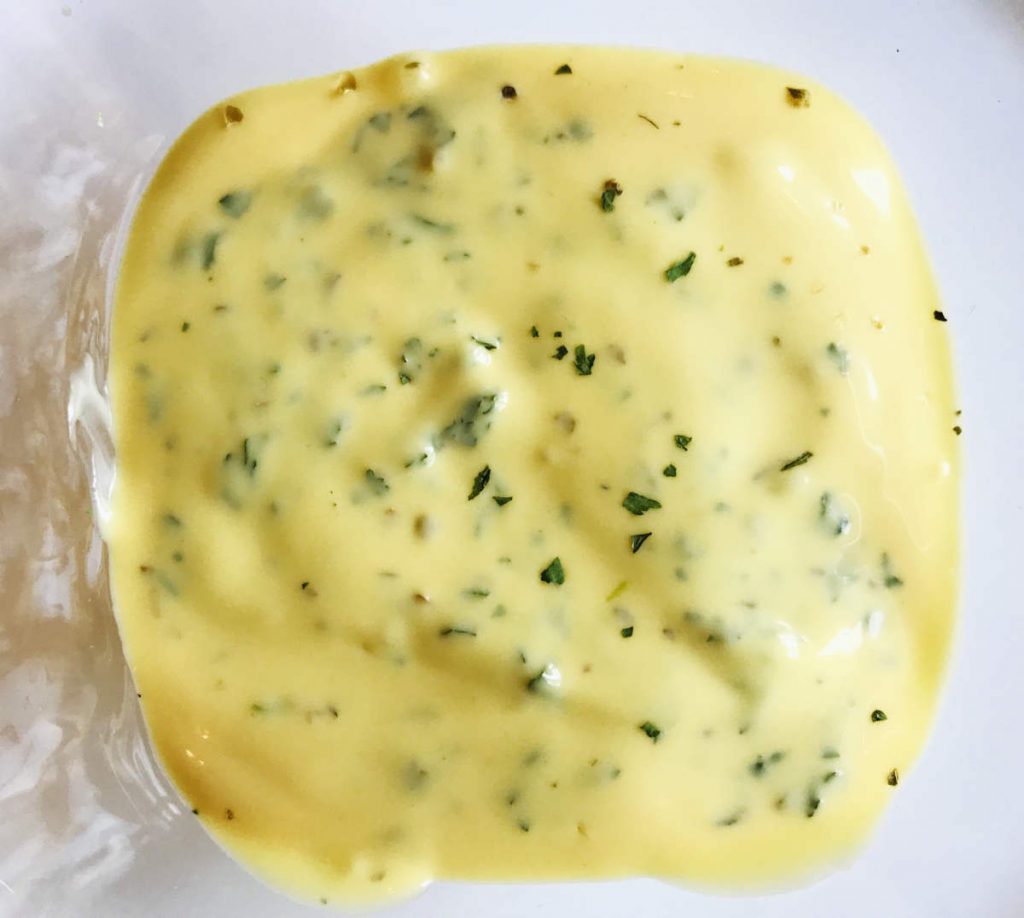
Ingredients in the béarnaise sauce include butter, egg yolk, white wine vinegar, tarragon, peppercorn, and herbs.
It also goes as well with other options like grilled fish and poached eggs and as a sauce with:
- lyonnaise quenelles
- in a hamburger
- quiche lorraine
You can get the recipe for béarnaise sauce here.
Beurre Blanc
The Beurre blanc, another sauce, is also sometimes called the Beurre nantais. Ingredients in beurre blanc sauce include French butter, vinegar or white while, and shallots.

This sauce is to be served warm as an accompaniment to seafood. It traditionally served with poached or grilled fish like pike, salmon, and codfish.
It also goes well with grilled shellfish like shrimp, crab and lobster. You can get the recipe for beurre blanc sauce here.
Beurre Noisette
Beurre noisette is a French cooking term which literally translates to “butter hazelnut”. No nuts involved here though. A beurre noisette instead involves unsalted butter is melted over low heat and start to attach to the bottom of the pan.
As it turns a lovely hazelnut brown color, the pan is removed from the heat, and the beurre noisette sauce is ready for serving.
Bien-cuit
Bien cuit in French translates to well-cooked and usually refers to meat, usually steak. (Other options are “saignant” – rare or “à point” – medium)
Bisque
A bisque in French actually refers to two different types of soup, which can be quite confusing:
i) Seafood bisque soup
The seafood version involves crushing and cooking imperfect crustacean seafood into a smooth, creamy, highly seasoned soup. The seafood bisque is generally made from lobster, langoustine, crab, shrimp, or crayfish.
ii) Creamy vegetable bisque soup
The second version of the bisque is a cream-based soup that do not contain seafood. Cooked ingredients like squash, tomato or mushrooms are pureed in a food processor and served as a creamy blended soup.
Blanche
Blanching is the process of boiling fresh vegetable for a short time, which is then rapidly cooled.
It preserves the crispness and bright color of vegetables, and it’s particularly useful for preserving the brightness of vegetables like green beans, broccoli, and zucchini. You can read more about how to blanche vegetables here.
Blanquette
Blanquette comes from the French word blanche meaning “white” and refers to the sauce made from cream and butter, or flour. A typical blanquette is slow-cooked on the stove for 1.5 hours. Eg. Creamy Chicken blanquette.
Bouillon
There are several types of bouillon in French cuisine:
i) Bouillon broth
A bouillon broth is made by cooking foods in water for a relatively long until the flavors and nutrients are transferred to the water. This broth is then drunk as a soup.
ii) Bouillon stock
A bouillon in French also refers to stock cubes or liquids of concentrated, broth. The stock can be vegetable, chicken, beef, or any other flavor to add into the dish.
iii) Court bouillon
There is also a court bouillon, where court in French translates to “short”. In a court-bouillon, the boiling time is much less, where only some of the flavors transfer to the water.
In this case, it is more of a method of poaching delicate ingredients like fish.
Bouquet Garni
A bouquet garni is cooking shorthand for a bunch of herbs all grouped together. Possible herbs included in the bouquet garni can include:
- bay leaves,
- parsley,
- thyme,
- coriander
- cilantro
- basil
- peppercorns
- taragon
The herbs are tied together with a string or put in a small sachet and put in the stew for cooking. It is then is removed before serving.
Brunoise
Brunoise is a French knife cut, where the thin matchstick size vegetables in the julienne cut (below) are cut even smaller into 3mm size cubes. The brunoise is usually used as a garnish top of dishes like a salad or a stew.
Chiffonade
A chiffonade is another knife cut where large leafy vegetables are shredded into thin strips. It is also usually used as an elegant garnish when tossed on top of various dishes.
Confit
Confit as a French cooking term that describes when meat is salted cooked in grease or oil at a low temperature. After salting and cooking in fat, confit can last for several months or years when sealed and stored in a cool, dark place.
The fatty confit is then used in recipes. Eg. confit de canard (meaning “duck confit”) which is traditionally used in a cassoulet recipe.
Coulis
A coulis is a smooth light sauce made from pureed fruits or vegetables cooked to a boil on the stove.
Fruit coulis are usually served as a garnish on desserts and cakes, while vegetable coulis are used on savory dishes.
Croquette
Croquette comes from the French word croquer, meaning “to bite”. And indeed a croquette is bite-size dumplings with filling inside.
The croquette is usually made from mashed potato or wheat flour, and can be filled with anything from meat to cheese and vegetables. The dumpling is then breaded and fried, like the spanish croquetas which are a tapas delicacy.
(Note: a croquette pour chien refers to dog food or dog kibble.)
(en) Croute
Croute in French means crust, and in essence, there are a whole series of dishes that are cooked en croute, meaning in a pastry crust. The starring ingredient is wrapped in a puff pastry crust and placed in the oven to cook. Eg. filet mignon en croute (beef in pastry crust)
Déglacer
Déglacer, or deglazing in English, involves pouring a little water at the bottom of a pan or a still hot dish where meat has just been to mix into the juices in order to make a sauce.
By stirring and scraping the bits of meat together, you get to retain all that lovely flavor. You can also deglaze with cream, wine, broth, or lemon juice, depending on the dish.
Démi-glace
A démi-glace a reduced sauce, that is a derivative of the espagnole sauce (explained below).
It is made from veal or beef stock and vegetables. It derives its texture and color from the caramelization of meats, fats and bones that have been cooked in it.
Escalope
An escalope refers to a thin slice of meat without any bone, typically from veal, which is then coated in flour and fried. The meat has usually been that has been thinned out using a mallet or rolling pin to tenderize it and break down the fibres.
Once cooked, the escalope is usually served in a creamy white sauce like béchamel or mushroom sauce.
Espagnole
Espagnole is a sauce which literally translates to Spanish sauce. Ingredients in the espagnole sauce include butter, flour, and beef stock, as well onions, carrots, celery, and tomato purée for flavoring.
The vegetables are removed before serving, after the sauce is reduced. The sauce is used as an accompaniment to meats or potatoes. Other daughter sauces include:
- Démi-glaze: a reduced espagnole sauce
- Bigarade: an espagnole sauce that is flavored with oranges and served with duck.
- Madeira: a reduced sauce, similar to the demi-glaze with Madeira wine added to it.
You can get the recipe for sauce espagnole here.
Farci
The French cooking term “farci” meaning stuffing, usually a vegetable stuffed with something else. It is a staple in provençale and mediterranean cuisine.
Often minced meat or lardons are used for the stuffing, but why not try cheese for a change. Eg. courgette farci à la brousse (stuffed zucchini with cheese).
Flambé
Flambé means to “set affire” in French, sometimes with alcohol, and is a common cooking technique in France.
A tarte flambée is a thin pizza that is a specialty in Alsace along the French-German border. Usually made from fromage blanc or crème fraîche, thin-sliced onions and lardons. (Also sometimes called Flammkuchen or Flammekueche.)
Fondue
The word fondue comes from the French word fondre, meaning to melt.
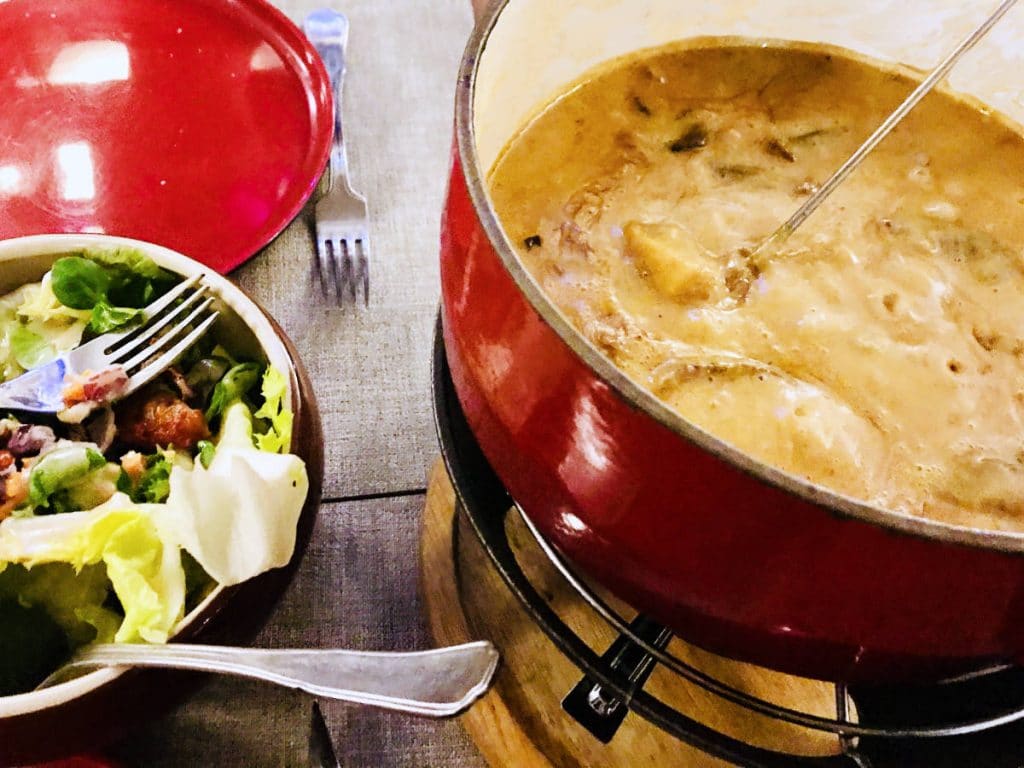
There are many types of fondue, with the most famous being:
- Cheese fondue: sauce made of melted cheeses with wine and garlic.
- Fondue Bourguignonne: mix of boiling oil and spices that is used to cook the meat.
- Butter fondue: melted butter sauce mixed with garlic, paprika and shallots.
- Mushroom fondue: sauce made of melted cheeses with wine and mushrooms.
- Chocolate fondue: melted mix of chocolate into a sauce.
Fricassée
It is not really clear where the word fricassée came from, it could be frire (meaning “to fry”) and casser (meaning to “to break”), but it is not really clear.
Julia Child in Mastering the Art of French Cooking describes fricassée as “halfway between a sauté and a stew”. In a fricassee, cut-up meat is first cooked at high heat in oil, and then liquid is added to let it simmer and finish cooking. Eg. fricassée de volaille (chicken stew)
Frit
The French word for “fried” is frit. So legumes frites would be fried vegetables. However, when it is just written frites, this refers to potato french fries.
Fumé
Fumé means to smoke, and is usually used to smoke hams for charcuterie or fish, like saumon fumé (meaning “smoked salmon”).
(au) Gratin
A gratin is usually a dish that is baked with a top crust of cheese and breadcrumbs. The word gratin comes from the French verb gratter which means, “to scrape.” For example, gratin dauphinois.
Hollandaise
Another very popular French sauce is tranquil hollandaise. Ingredients in the hollandaise sauce include egg yolks, melted butter, and lemon juice.
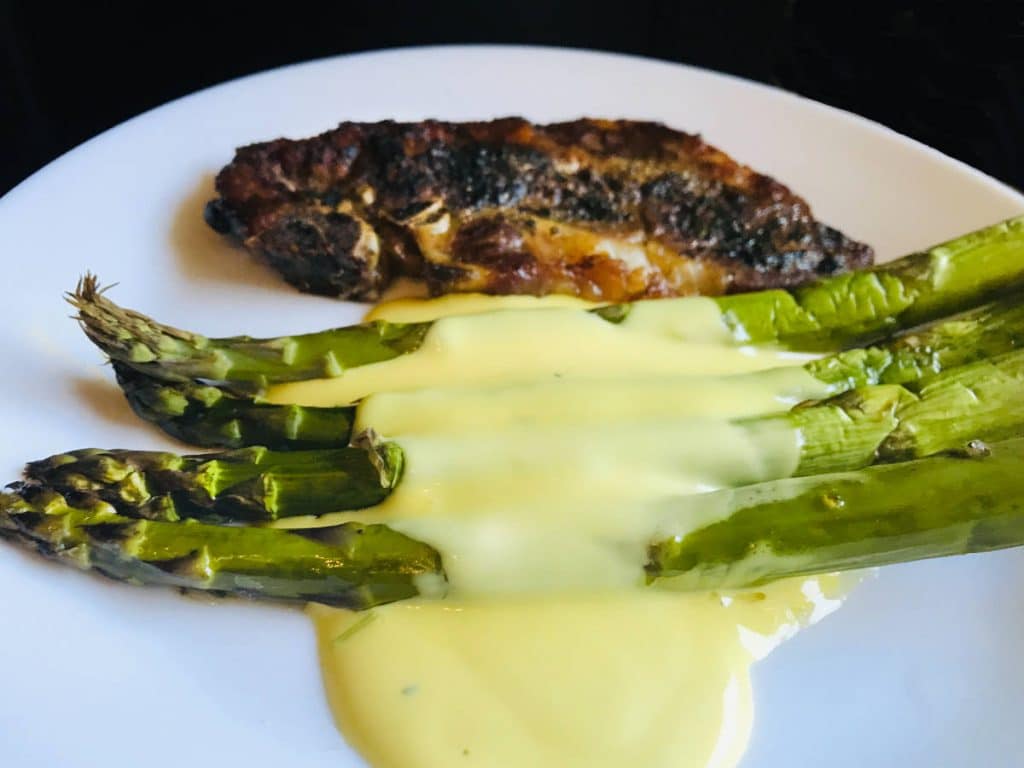
The hollandaise sauce goes well with many dishes, especially seafood liked poached codfish or baked salmon.
The hollandaise can also be used to add flavor to as well as any type of green vegetable (asparagus, brocolli, etc.) You can also use it as a sauce with:
- spinach quiche
- eggs benedict
- baked potatoes
Daughter sauces of the hollandaise include:
- Choron: hollandaise with tarragon and tomato
- Maltaise: hollandaise with blood orange juice
- Mousseline: hollandaise with whipped heavy cream
You can get the recipe for hollandaise sauce here.
Hors d’oeuvre
Hors-d’œuvre in French literally means “outside work” which is to say not part of the ordinary set of courses in a typical French meal. It is not exactly the same as an appetizer, although in English you will often see the words interchangably.
The best way to describe it is if you go to an event like a French wedding. You will have hors-d’œuvres with champagne while mingling with guests at the vin d’honneur apèro. And then when it is mealtime, you will take a seat and be served an appetizer.
Julienne
A julienne is a type of French knife cut, where the vegetable is cut in long thin strips about the size of a matchstick. Eg. Carrots julienne or oignons julienne.
(au) Jus
Au jus is a French culinary term meaning “with juice.” The same as deglazing, it uses the meat’s own juice to create a sauce that is served with the meat.
Meunière
A meunière is a cooking term used to describe the process of flouring fish and then cooking it in oil. Eg. Sole meunière. The traditional English fish and chips would be poisson meunière et frites.
Mijoter
Mijoter in French means to cook slowly at a low temperature. It is basically slow-cooking, or to “let stew”.
Mirepoix
A mirepoix is an aromatic flavor base made by lightly cooking vegetables , usually onions, celery, and carrots in butter or oil. It is cooked at low heat in order to gently extract the flavors without browning or caramelizing the vegetables.
The vegetables are then strained out and removed from mirepoix, once that flavoring base is set. The mirepoix is then added to stews cooking meat, game or fish.
It is rather similar to the espagnole sauce although the espagole sauce is served directly, while a mirepoix is added to stews and other dishes to add flavor.
Pâté
A pâté is a paste made of ground meats and organ meats, usually containing a portion of chicken, goose, or duck liver, along with herbs, and spices. In the olden days it was made at home using leftover insides of meats.
Examples include: Pâté de foie gras, paté de canard (duck), paté de poulet (chicken). Vegetarian patés are also available.
These days, it is widely available in food stores and grocery shops. It is usually served as part of a charcuterie and cheese platter. You can read more about pâtés here.
Pistou
The Pistou is the French version of the Italian pesto sauce. Ingredients in pistou sauce include garlic, olive oil and basil. Pistou can serve as a sauce for dishes like pastas, baked chicken, or with a side of steak.
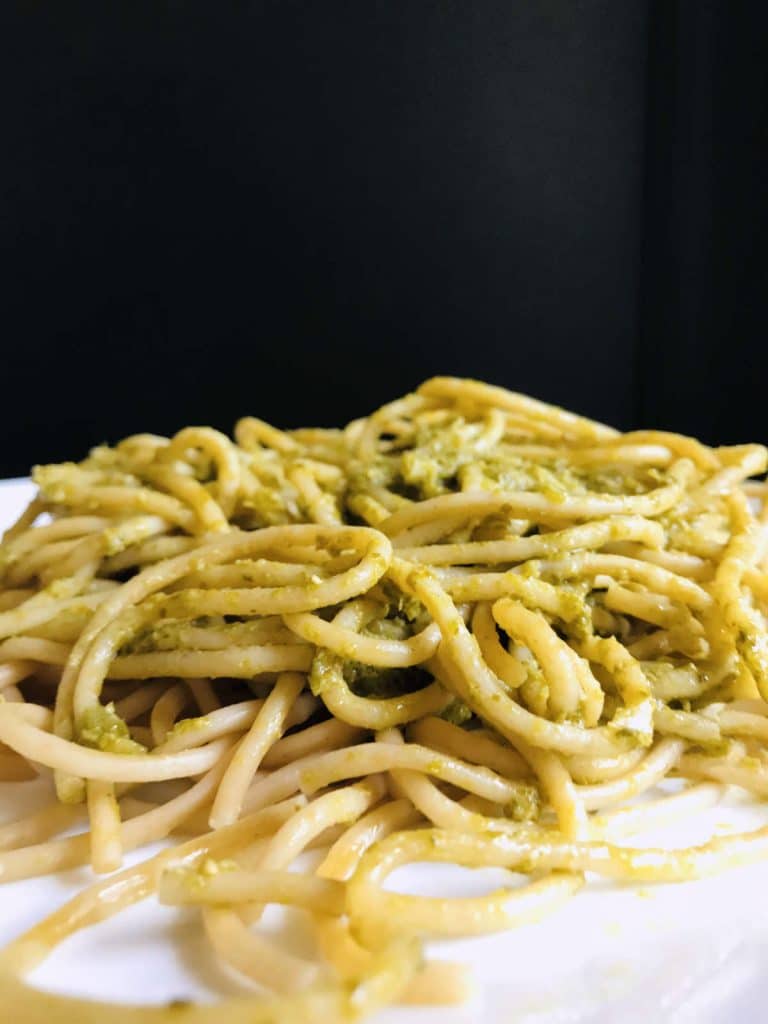
It can be a bit strong for fish dishes as it can overwhelm them, so use in moderation. However, it is excellent as an accompaniment to baked salmon or tuna. You can get the recipe for pistou sauce here.
(en) Papillote
A papillote is a cooking process where the food is wrapped in baking paper or foil and then cooken in the oven. It is a gentle stewing and steaming of the food, to retain its nutrients.
Aluminum foil is generally not used as it can become toxic when mixed with acidic citrus juices, but otherwise any sort of baking paper is fine. You can even cook it in a microwave, if you don’t have time for an oven.
Poaché
Poaché (meaning poaching”) involves cooking food in a liquid such as water, broth, milk, or wine, at a temperature that is not boiling, but rather simmering.
This moist heat method of cooking is a technique that is used to cook delicate proteins such as fish, chicken, and eggs, as well as vegetables.
Ragoût
A ragoût is a stew, usually containing meat and several varieties of vegetables, all slow cooked together. The meat and vegetables that you choose are up to you, although sausages and fresh vegetables that are in season are the norm.
Interestingly, the word ratatouille is traditionally thought to be army slang for ragoût, meaning “motley stew”. However, it is not exactly the same, as ratatouille does not usually have meat in it, while a ragoût does.
Remuer
You often hear the word remuer in French cooking, example “Remuer un sauce” or “remuer la salade“.
It means mixing, with a spatula or a whisk, a preparation, during its preparation or cooking, so that all the ingredients are distributed evenly and do not clump together.
So “remuer la salade” just means turning the leaves several times, at the last moment, to coat them well with the seasoning.
Rillettes
Rillettes are meat insides that have been shredded then slow-cooked and preserved in fat. They can be made at home, but most French people do buy them at the butcher or in a supermarket these days.
They are usually served in France on a charcuterie platter. Example: Duck, pork or goose rillettes. New varieties of crab and seafood rillettes are also available.
Rouille
A rouille is a spicy sauce originating from Provence in the south of France. Rouille sauce is usually served with bouillabaisse, but you can also serve it as a sauce to accompany meat, grilled fish, or potatoes.
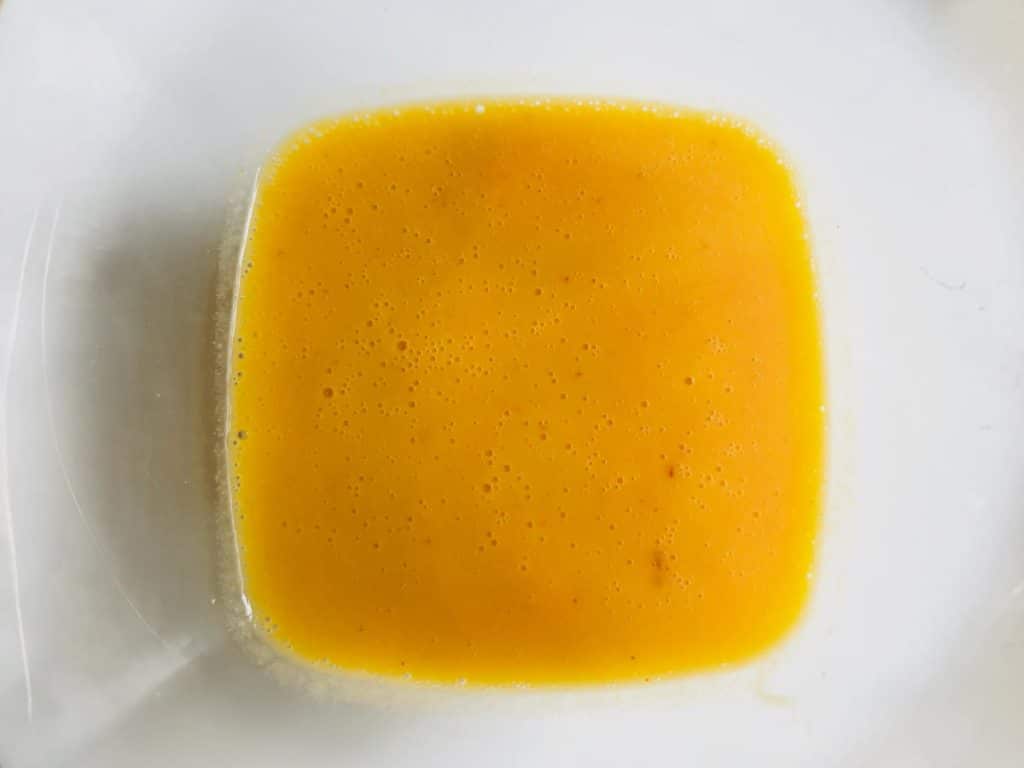
Pronounced “rou-iy”, ingredients in the rouille sauce include egg yolks, olive oil, mustard, garlic, saffron, and cayenne pepper.
As a sauce, it can go with just about any apéro finger foods from french fries and charcuterie, to escargot. As a simple idea, serve it with pain complet country bread, or baguette.
You can get the recipe for rouille sauce here.
Roux
You know that moment when you try to make a stew or sauce and it is a bit too watery? This is where “thickening a sauce with roux” comes in.
One of the most common ways of thickening a sauce is by mixing a combination of flour and butter. However, if you add the butter and flour in directly, the flour may not mix as well and turn rather lumpy.
A roux is made by stirring the flour into melted butter and then cooking it for a few minutes so that the flour taste is no longer noticeable. This is then added to the watery stew or sauce to thicken it up.
Saignant
Saignant in French means “bloody”, and it is just as it sounds for the meat to be so lightly cooked or rare that is dripping with red blood juices.
This is as opposed to cooking meat are “bien cuit” meaning well-cooked or “à point” meaning medium.
Sauté
Sauté comes from the French word sauter, meaning to jump. A sauté is a cooking technique involving cooking foods at high temperatures, usually on a stove top.
The food is tossed and turned quickly in oil, making it “jump” until it is browned.
Soufflé
Soufflé comes the French world souffler, meaning to breathe or blow air into. A soufflé is an egg-based dish which involves folding whipped egg whites into a base, like béchamel sauce or vegetable purée.
The combination of egg whites and the base make the dish rise, making the soufflé a success.
Sous Vide
Sous vide in French translates to “under vacuum”, and is a French cooking technique in which food is placed in a plastic pouch (or glass jar) and cooked in a water bath.
The cooking temperature is much lower, around 130-140 °F (55-60 °C) for red meat, 150-160 °F ( 66-71 °C) for poultry, and higher for vegetables.
The idea is to cook the item evenly at a low temperature but for a long time to ensure that the inside is properly cooked and yet to retain moisture. Cooking times can range anywhere from 1 to 72 hours at a precisely regulated temperature.
Tartare
A tartare in French has two meanings:
i) Tartare dish
A tartare dish, includes a round arrangement of raw meat or fish that has been chopped or shredded into small pieces. It is usually served with a light salad and fries for a light lunch or dinner. You can find a salmon tartare recipe here.
ii) Tartare sauce
Tartar sauce is usually served with breaded dishes like the English fish and chips.
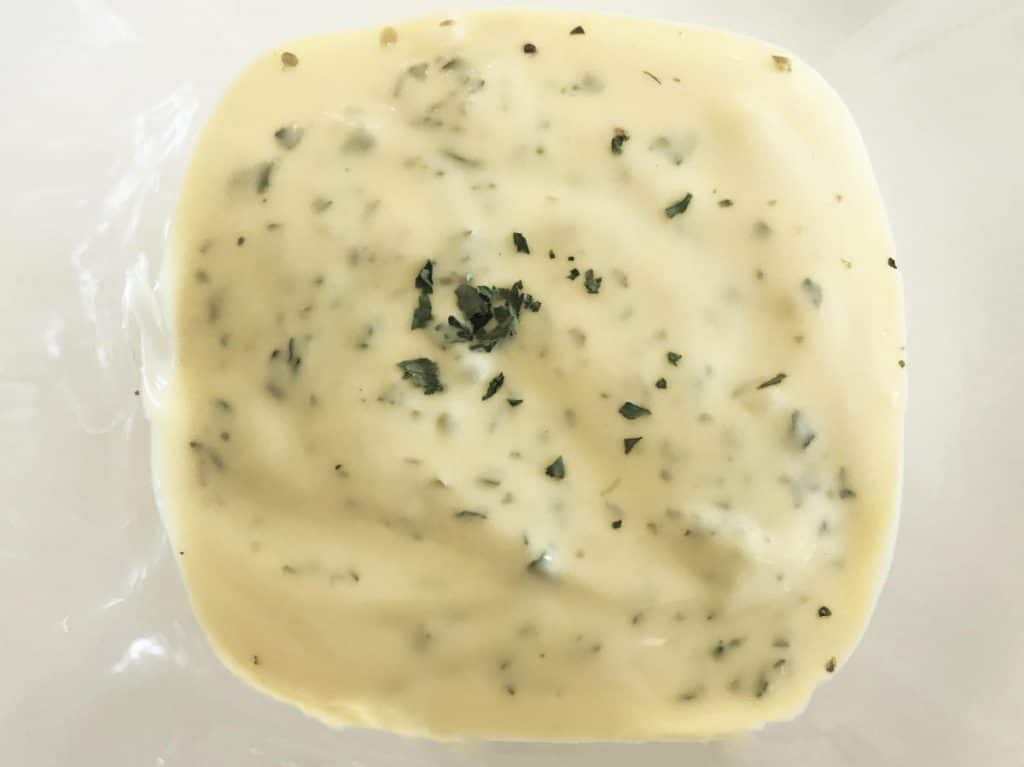
Ingredients in tartar sauce include egg yolk, chopped pickles, capers and herbs such as tarragon and dill.
Tartare sauce also goes well with fried seafoods like shrimp, oysters, and fish fingers, or breaded meat like schnitzels from Alsace. You can get the recipe for sauce tartare here.
Tartine
A tartine is a spread put on a bread, such as a chocolate tartine, which is a popular after-school snack in France.
It is an open-faced sandwich, and can easily be served for lunch. (An avocado toast would be considered a type of tartine.)
Terrine
A terrine is a paste made of ground meats and organ meats, similar to Pâté. Unlike a pâté however, a terrine is usually oven-cooked in an earthern dish, with vegetables and spices added. It can also be wrapped in pastry.
Examples include: Terrine de campagne, terrine de canard, terrine de foie gras.
Tomate
When is a tomato sauce not just a tomato sauce? When it is one of the 5 French mother sauces, of course.
Tomato sauce is one of the basics of Mediterranean cuisine. Ingredients in the classic French tomato sauce include tomatoes, lardons, onions, bay leaves, thyme, garlic, salt, pepper, and a teaspoon of sugar.
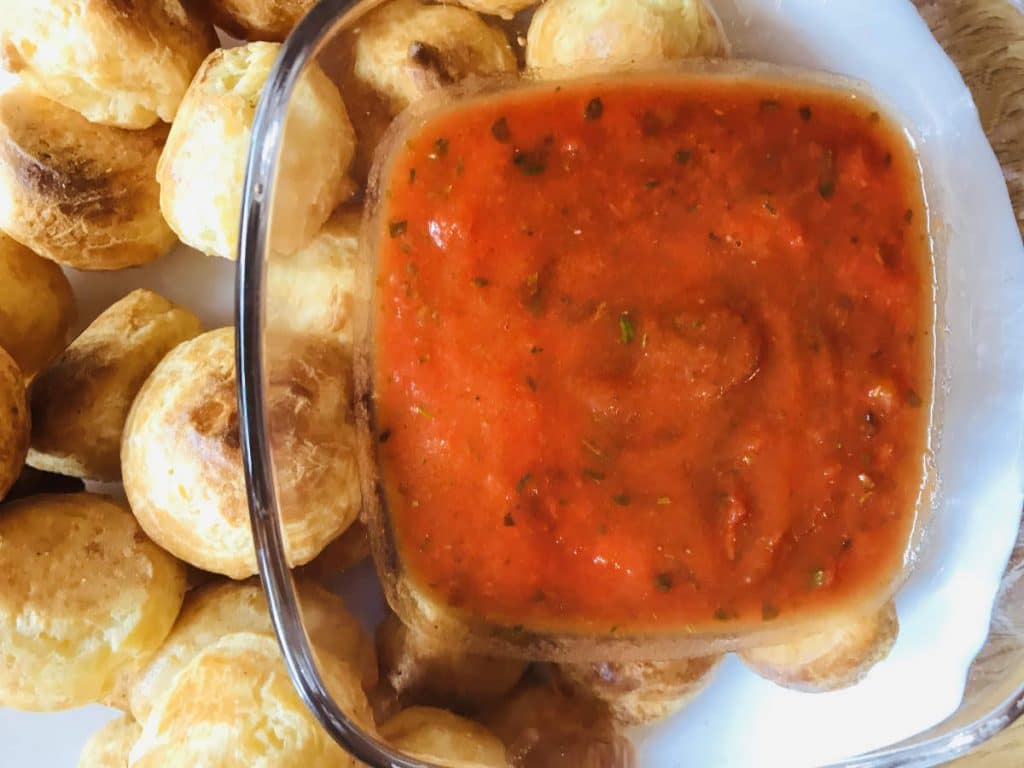
Pasta is always a favorite with tomato sauce, but you can also serve it with baked chicken or fish like salmon or codfish. You can even use it as a topping on baked eggplant (aubergine) or a sauce with gougères. Other ideas would be to serve it with quinoa or polenta.
Other daughter sauces include:
- Creole: tomato sauce with white wine, garlic, onion, cayenne pepper, and red bell peppers.
- Portugaise: tomato sauce with garlic, onions, salt, herbs, and peeled tomatoes.
- Provençale: tomato sauce with olive oil, parsley, garlic, salt, pepper, and sugar.
- Marinara: tomato sauce with garlic, onions, and herbs.
You can get the recipe for tomate provençale sauce here.
Vélouté
Vélouté (pronounced “veh-loo-tay”) has two meanings:
i) The Velouté Sauce
ngredients in a velouté sauce include butter, flour, and chicken stock.
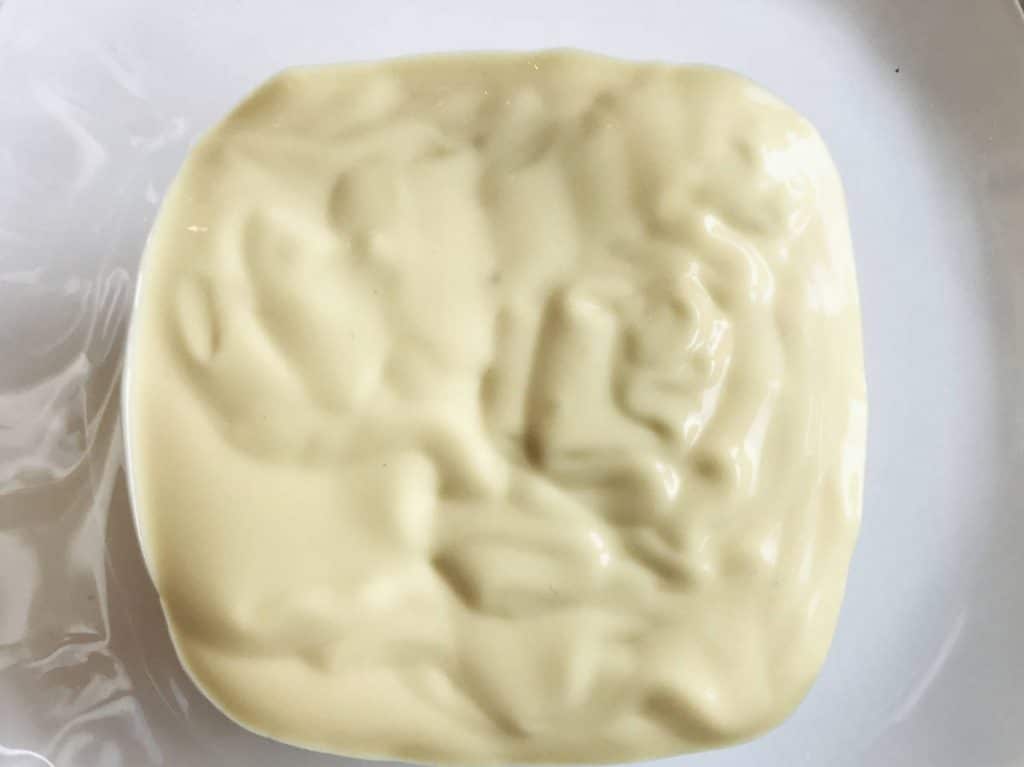
Other daughter sauces include:
- Allemande: chicken or veal velouté with lemon juice, egg yolk, and cream.
- Poulette: chicken velouté with heavy cream and mushrooms.
- Hongrais (Hungarian): chicken or veal velouté with onion, paprika, butter, and white wine.
- Vénitienne (Venetian): chicken or fish velouté with tarragon, shallots, and parsley.
- Normande: fish velouté with cream, butter, and egg yolks.
You can get the recipe for velouté sauce here.
iI) Vélouté Soup
A vélouté is also a well-blended soup, usually from vegetables. The vegetables are pressure-cooked and then blended together using a blender until smooth.
A vélouté is a common dish in winter, and when French people are looking to lose weight and get healthy.
Verrine
A Verrine is a dish served in a glass cup, usually as an appetizer. The word derives from the French world verre, meaning glass.
For example: verrine de saumon fumé et avocat (meaning glass cup with smoked salmon and avocado.)
Vol-au-Vent
A vol-au-vent is a puff pastry that can be filled with various ingredients, like chicken and mushrooms, escargot, etc.
It is like a meat or chicken pot pie, except it is usually made in individual size portions, since it is usually served as an appetizer.

If you enjoyed that article, you may enjoy reading about some French cooking basics here. A bientôt!

